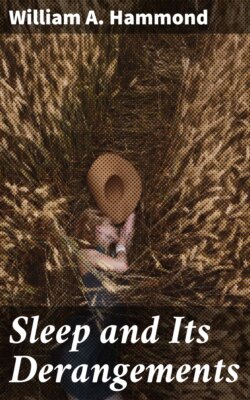Sleep and Its Derangements

Реклама. ООО «ЛитРес», ИНН: 7719571260.
Оглавление
William A. Hammond. Sleep and Its Derangements
Sleep and Its Derangements
Table of Contents
PREFACE
CHAPTER I
CHAPTER II
CHAPTER III
CHAPTER IV
CHAPTER V
CHAPTER VI
CHAPTER VII
CHAPTER VIII
CHAPTER IX
CHAPTER X
CHAPTER XI
CHAPTER XII
APPENDIX
Отрывок из книги
William A. Hammond
Published by Good Press, 2021
.....
Experiment.—I placed three dogs of about the same size under the influence of chloroform, and removed from each a portion of the upper surface of the skull an inch square. The dura mater was also removed, and the brain exposed. After the effects of the chloroform had passed off—some three hours subsequent to the operation—I administered to number one the fourth of a grain of opium, to number two a grain, and to number three two grains. The brain of each was at the time in a perfectly natural condition.
At first the circulation of the blood in the brain was rendered more active, and the respiration became more hurried. The blood-vessels, as seen through the openings in the skulls, were fuller and redder than before the opium was given, and the brain of each animal rose through the hole in the cranium. Very soon, however, the uniformity which prevailed in these respects was destroyed. In number one the vessels remained moderately distended and florid for almost an hour, and then the brain slowly regained its ordinary appearance. In number two the active congestion passed off in less than half an hour, and was succeeded by a condition of very decided shrinking, the surface of the brain having fallen below the surface of the skull, and become pale. As these changes supervened, the animal gradually sank into a sound sleep, from which it could easily be awakened. In number three the surface of the brain became dark, almost black, from the circulation of blood containing a superabundance of carbon, and owing to diminished action of the heart and vessels it sank below the level of the opening, showing, therefore, a diminished amount of blood in its tissue. At the same time the number of respirations per minute fell from 26 to 14, and they were much weaker than before. A condition of complete stupor was also induced from which the animal could not be aroused. It persisted for two hours. During its continuance, sensation of all kind was abolished, and the power of motion was altogether lost.
.....